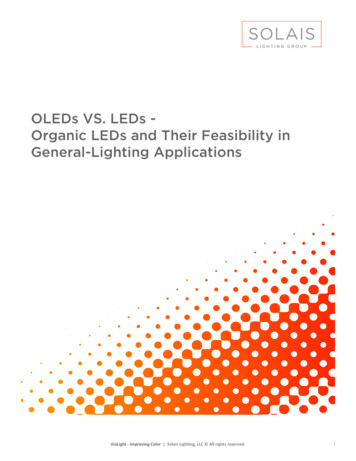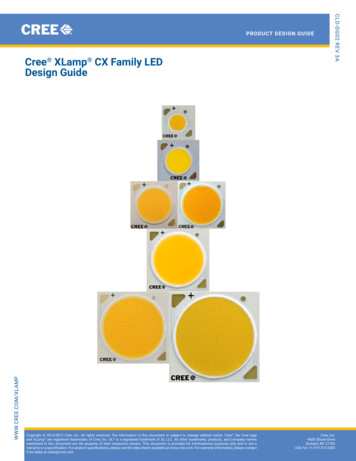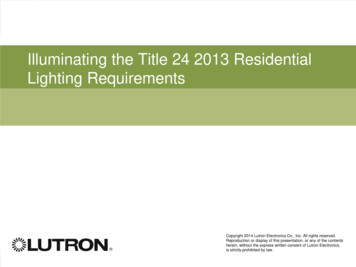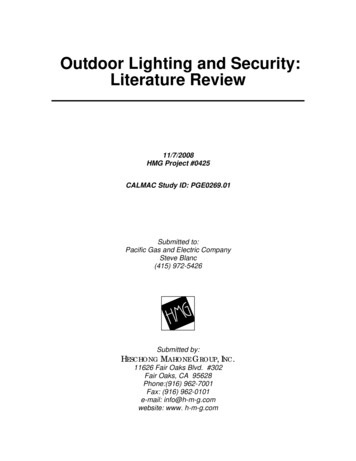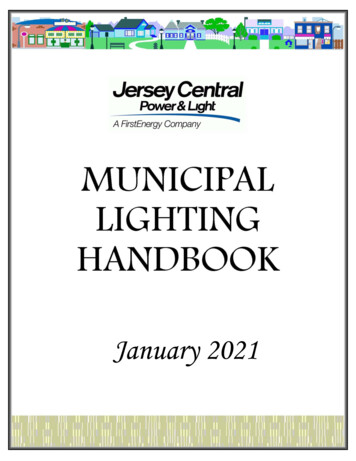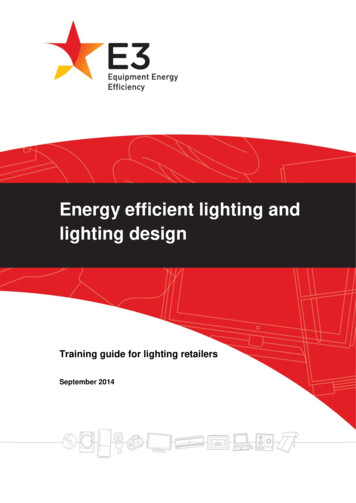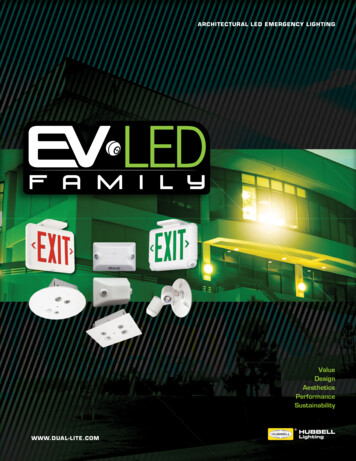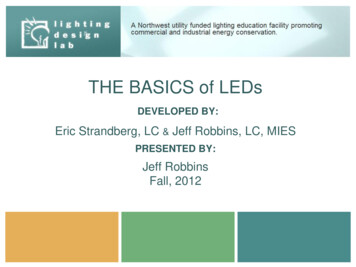
Transcription
THE BASICS of LEDsDEVELOPED BY:Eric Strandberg, LC & Jeff Robbins, LC, MIESPRESENTED BY:Jeff RobbinsFall, 20121
LIGHTING DESIGN LABA Northwest utility funded lighting education facilitypromoting commercial and industrial energy conservation.2
OUR FACILITY3
OUR FACILITY4
OUR SERVICES Lighting Classes (local and regional) Product Evaluations Demonstration Area Mock-Up Facility LDL LED Qualified Products List Lighting Library Lighting Consultations Tours of Facility Website Resources Newsletter Outdoor Lighting Center Lighting Guides Technical Information General Information5
WEBSITE6
CONTENT OUTLINEPart 1: The Basics Diode DefinedLED DefinedA Brief HistoryAdvantagesHow they WorkLamp AnatomyHow They Produce ColorsHow They Produce ‘White’ lightFixture AnatomyPart 2: DetailsA. Evaluating Light OutputB. Quality of LightC. Fixture Efficacy1.2.3.4.5.6.7.Off-state Power ConsumptionPower FactorThermal ManagementUseful LifeDriving and PoweringControllingDimmingD. Questions to AskE. ReferencesF. Terms and Terminology7
Part 1: THE BASICSDiode Defined In electronics, a diode is acomponent that restrictsthe direction of movementof charge carriers.Essentially, it allows anelectric current to flow inone direction. In simple terms, a switch.8
LED Defined A Light Emitting Diode is asemiconductor device thatemits visible light of acertain color, and isfundamentally differentfrom conventional lightsources such asincandescent, fluorescent,and gas-discharge lamps,in that an LED: uses no gas or filament,has no glass bulb, and no failure-pronemoving parts.9
A Brief History In 1962 the first red LED was developed by NickHolonyak at G.E. Throughout the 60’s red LEDs wereued as small indicator lights on electronic devices. Green and yellow LEDs were introducedin the early 70’s, and were used inelectronics, traffic signals, exit signs,and watches, etc.10
A Brief History, (cont.) By 1990, LEDs of one lumen output were available.In 1993, Shuji Nakamura at Nichia created the firsthigh-brightness blue LED, making it possible to RGBmix to any color. This was followed in 1996 by the development ofPhosphor White LEDs, which combined a blue orultraviolet LED with a phosphor coating that producedwhite light.11
A Brief History, (cont.) By 2005, output levels of 100 lumens were possible.white light LEDs became available in various shades.LEDs began competing with conventional lightsources and fixtures in general illuminationapplications. The Department of Energy expects LED technologyto become the preferred method of lighting in homesand offices by 2025.12
Advantages Comparable in efficacy toCFLs, gaining onfluorescent tubes, andincandescents. Fixtures are directional,allowing for more efficientoptics. Quality of White Light LEDsnow comparable to CFLs,recent advances assurebetter consistency in colorand CCT. Significantly longer ‘Useful’life.13
Advantages (cont.) Light output has improved by 35% / year, while costhas dropped by 20% / year No infrared, (IR) radiation No ultraviolet, (UV) rays Mercury free Can operate in cold environments Can withstand impact and vibrations Inherently digital for ease of control Instant on Growing trend to modularity14
0How They Work Like a normal diode, theLED consists of a chip ofsemiconducting materialimpregnated, or doped withimpurities to create a p-n,(positive / negative) junction. Atoms in the n-typematerial have extraelectrons, atoms in the ptype material have electronholes.15
How They Work (cont.) Applying current pushesthe atoms toward thejunction. When they getclose, the n-type atoms’donate’ their extraelectrons to the p-typeatoms which ‘accept’ them.CURRENT A negative charge to the nside allows current to flowfrom the (-) charged area tothe ( ) charged area. Thisis called ‘forward bias’.16
How They Work (cont.) When extra electrons in the n-type material fall intothe holes in the p-type material, they release energyin the form of photons. The material in an LED isselected so that the wavelength of the photons fallswithin the visible portion of spectrum. Different materials produce photons at differentwavelengths / color.17
Lamp Anatomy, Indicator-Type Typically 5mmUsually inexpensiveLow PowerGenerated heatdissipated internally Used only in: Panel Displays Electronic Devices Instrument Illumination18
Lamp Anatomy, Illuminator-Type AKA surface-mount LEDsHigh Brightness LEDsDurable, high-power devicesCapable of providing: Functional illumination Light output equal to, or surpassing many conventionalsources19
Lamp Anatomy, Illuminator-Type (cont.) All Illuminator-Type LEDs share the same basicarchitecture: A semiconductor chip, (or die)A substrate that supports the chipContacts to apply powerBond wire to connect the contacts to the chipHeat sink plus surface-mount solderconnections provide a thermallyconductive path Lens Outer casing20
How They Produce Colors LEDs produce different colors byusing different material systems,each system producing photonsof different wavelengths. Illuminator-Type LEDs usesystems which can handle thenecessary heat, current, andhumidity to produce highbrightness red and amber, (AllnGaP), and high-brightness blue,green and cyan, (InGaN). Alln-GaP and InGan coveralmost the entire spectrum. A gap occurs in the yellowgreen portion, which canbe filled by includingdifferent color LEDs in thesame device.21
How They ProduceColors (cont.) An LED can: Only emit the one colorthat the specificcomposition of itsmaterials can produce. Combine red, green andblue in a single device. Create millions of colorsby controlling the relativeintensity of each color. Use the ‘additive’ RGBcolor mixing process.(The ‘subtractive’ colormixing refers to pigments.)22
How They Produce Colors (cont.) The Color Space chart defines the gamutof visible colors. The gamut of colors an LED fixture canproduce depends on the specific colors ofthe red, green, and blue LEDs used in thefixture or chip. In theory a tricolor device can reproduceany color within the gamut.23
How They Produce ‘White’ Light Method 1 – RGB mixing (previously covered) Better control over exact color. Is hardware intensive / expensive Tends to make pastels look unnatural, hence poor CRI24
How They Produce ‘White’ Light (cont.) Method 2 – Phosphor White (Remote Phosphor) Produces white light in a single LED by combining a shortwavelength LED, (blue), and a yellow phosphor coating. The blue photons either pass through the phosphor layerwithout alteration or are converted into yellow photons inthe phosphor layer. The combination of blue and yellowphotons produce a bluish ‘White’ lightwith better CRI, and is more efficientthan RGB.25
Fixture Anatomy To be used for illumination, LEDs must be integratedinto systems that incorporate: Optics – Reflector cups, lensing and aiming features Drivers – Microprocessor-based power management,and control stages Power Supplies – voltage conversion units Thermal Management – vents and heat sinks Well designed fixtures integrate all these features intothe fixture itself. Effectively erases the distinction between lamp & luminaire.26
Part 2: DETAILSA. Evaluating Light Output1.2.3.4.5.6.Light Output DefinedThe Trouble with Lumen EvaluationDelivered LightRelative PhotometryAbsolute PhotometrySources of Light Loss27
1. Light Output Defined How much light a fixture produces, and how the fixture emits anddistributes that light. Data describing the quantity and distribution of the visible light producedis photometrics. The specification most commonly used for evaluating and comparingthe performance of ‘conventional’ lighting fixtures is lumen output.28
2. The Trouble with Lumen Evaluation The way that lumen output is traditionally measured, reported andinterpreted is a problem for evaluating and comparing LED fixtures. Lumens are an imperfect measurement of the ‘perceived’ intensityof light. LED fixtures and conventional fixtures are tested differently, hencesome photometric data is reported differently. A fixture’s total lumen output does not account for wasted light. LED fixtures typically waste less light than conventional fixtures. ‘Eye Sensitivity Curve’ adjusts lumen content by source’s SpectralPowder Distribution.29
3. Delivered Light Instead of lumen output, it is the most relevant measurementfor evaluating LED fixtures and for making accuratecomparisons to conventional fixtures. Describes how much ‘Useful Light’ a fixture can deliver to thetask area. ‘Useful Light’ is the portion of a fixture’s output thatis effectively delivered to the task area, discounting anywasted light.30
4. Relative Photometry The way in which conventional fixtures are tested Luminaires and their lamps are tested separately Lumens and chromaticity of lamps measured with anintegrating sphere. Distribution and efficiency measured with a goniophotometer. Lamp lumen output serves as a reference. Lumen output of the fixture is measured relative to it.31
32
5. Absolute Photometry The way in which LED fixtures are tested The approved procedures and testing conditions are listed inIES LM-79-08, “Electrical and Photometric Measurementsof Solid-State Lighting Products”. Because LEDs are inseparable from their fixtures,only fixture lumens measured, not lamp lumens. For a valid comparison, the measured lamp lumensof a conventional fixture must be reduced by itsefficiency, as reported in a Zonal Lumen Summarychart.33
ZONAL LUMEN SUMMARYLamp Lumens 820Zone0-300-40Lumen %Lamp %Fixt.11312.119.619923.134.60-603820-9053490-120 3844.462.14.466.392.892.890-130 404.77.090-150 414.87.290-180 414.87.20-18066.910055034
6. Sources of Light Loss Delivered light to the task surface depends on arange of factors: Lumen output and lamp lumen depreciation Fixture positioning Lensing, filtering, shading, and accessories to redirect oralter the output-BUT LED fixtures are inherently directional, minimizing losses LEDs are natively colored, also minimizing losses35
Part 2: DETAILSB. Quality of Light1. CRI & White Light LEDs2. CRI vs. CQS3. Color Consistency36
R91. CRI and White Light LEDs2. CRI vs. the Color Quality Scale (CQS) The CIE has concluded that CRI can’t effectively predict thecolor quality of white light LEDs. The National Institute of Standards and Technology (NIST), isdeveloping a Color Quality Scale that does a better job ofmeasuring the color rendering abilities of white light LEDs. It uses 15 color samples, not the usual 8 CRI patches. Has not yet been widely adopted by luminaire testing labs.37
3. Color Consistency An index of light quality for both color and whitelight LEDs. Uses CCT, which allows for a range of variation inchromaticity that can be discerned by viewers,even if the CCT value is the same. Manufacturers strive to keep color variations undercontrol.38
3.1 Color Consistency (cont.) Understanding CCT and Binning Light sources with the same defined CCT can displaydiscernible differences in hue. LED makers use a method of managing manufacturingvariations in chromaticity and CCT known as ‘Binning’. The threshold at which a color difference becomesperceptible is defined by a MacAdam Ellipse. A color difference of 1 step is not visible. A color difference of 2-4 steps is barely visible. A color difference of 5 or more steps is readily noticeable.39
As few as 3 stepsAs many as 7 steps40
Part 2: DETAILSC. Fixture Efficacy1.2.3.4.5.6.7.8.Off-State Power ConsumptionPower FactorThermal ManagementUseful LifeDriving & PoweringControllingDimmingTrend toward Modularity41
1. Off-State Power Consumption Can significantly reduce system efficacy. Occurs when fixture switches or dimmers are positionedbetween the power supply or transformer, and the fixtures. Transformer continues to draw power even when the fixturesare off. Transformer power can draw in excess of 2 watts. The resulting total cumulative losses can represent as muchas 20% of a system’s load.42
2. Power Factor (PF) A measure of how effectively a device converts electriccurrent into useful output power.Real Power (Watts)Apparent Power (Volt-Amps) EXAMPLE: An LED lamp rated at 18 watts, when measuredactually draws 20 volt-amps. The PF of that lamp/driveris18W / 20VA, which is 0.9, and is considered high. EXAMPLE: A CFL lamp rated at 18 watts, when measured,actually draws 30 volt-amps. The PF of that lamp/ballast is18W / 30VA, which is 0.6, and is considered low.43
2. Thermal Management The light beam from an LED iscool, but because they are notperfectly efficient, a great dealof heat can be generated atthe p-n junction. A welldesigned heat sink and otherthermal management featuresare critical for assuring: Proper operation Optimizing light output Maximizing lifetime44
2.1 Thermal Management (cont.) Junction Temperature As it increases, output and ‘lifetime’ decrease Factors are:– Drive current– Thermal path– Ambient temperature45
2.2 Thermal Management (cont.) Junction Temperature Affect on Light Output– Manufacturers measure at fixed junction temp. of 25oC.– Actual range of temperatures: 60oC. to 90oC.– Result is at least 10% less light than manufacturer rating. Affect on Useful Life– An increase of 11oC. can reduce lifetime by 50% .46
3. Useful Life Rated Lamp Life of Conventional Sources Well established methodology: LM-49, LM-65, Life rated at 50% failure point Lumen Maintenance and Depreciation IES publication LM-80-08Counterpoint to LM-49 and LM-65Instead of rated life, LM-80 measures lumen depreciationFactors include:– Drive current– Heat generated within the device47
3.1 Useful Life (cont.) Lumen Maintenance and Depreciation (cont.) Maintenance measurement: Lp L is initial output P is the percentage maintained over a number of hoursi.e. L70 measure how long a source will retain 70%,(or lose 30% of its initial output)Knowing an LED’s Useful Life is important because theycontinue to deliver light after initial output has decreased by50%., or more. Users need to know how long an LED fixturewill retain a meaningful percentage of its initial light output,NOT how long will it take to fail.48
3.2 Useful Life (cont.) Useful Life Defined The length of time a light source delivers a minimumacceptable level of light in a given application. Changes in light levels go undetected down to 70% of initiallevels, especially if change is gradual. For general lighting applications, Useful Life could thereforebe defined as the length of time it takes an LED source toreach 70% of its initial output, L70 For decorative applications, (and for Energy Star), Useful Lifecan be rated as low as L5049
3.3 Useful Life (cont.) Additional Testing Criteria LM-80 requires testing ofLED sources for 6,000hrs.(though it recommends10,000 hrs.) Three different junctiontemperatures:– 55oC.– 85oC.– A third at the option ofthe manufacturer TM-21 establishes criteriafor projecting long termlumen maintenance ofLED sources.50
3.4 Useful Life (cont.) Useful Life of LED Sources in Fixtures LM-79 calls for the testing of complete lighting fixtures. Measuring lumen maintenance requires the testing of LEDsources. LM-80 testing for complete LED fixtures would be complexand expensive. In practice, reputable fixture manufacturers ensure drivecurrent and operating temperatures fall within the range ofsource manufacturer’s lumen maintenance reports, theymake calculations of the Useful Life of the LED sources theyare integrating into their fixtures.51
3.5 Useful Life (cont.) Comparing Useful Life – LED to Conventional 60-watt incandescent, LLD* of 15%, rated life of 1,000 hrs.– 10% loss at 600 hrs. Useful life is 1,800 hrs.– Lamp will fail before L70.– Rated Life is its Useful Life 18-watt CFL, LLD* of 10%, rated life of 15,000 hrs.– 10% loss at 6,000 hrs. Useful life is 18,000 hrs.– Lamp will fail before L70.– Rated Life is Useful Life*Light Lumen Depreciation52
3.6 Useful Life (cont.) Comparing Useful Life – LED to Conventional 32-watt HP T8, LLD of 5%, Rated Life of 60,000 hrs. 5% loss at 24,000 hrs. Useful Life of 79,200 hrs. Lamp will fail before L70. Rated Life is Useful Life.Conclusion: Comparisons of conventional fixtures to LED fixtures mustbe on a Rated Life-to-Useful Life basis.53
4. Driving and Powering LED Driver An electronic circuit that converts input power into a currentsource in which current remains constant despite fluctuationsin voltage. Fixtures that feature integrated LED drivers are as easy toconnect to power as any conventional fixture. An increasing number of integrated drivers for white lightLED fixtures are dimmable.54
4.1 Driving and Powering (cont.) Power Options for LED Fixtures Low-Voltage Power Distribution– Requires a low-voltage power supply (brick)– Lighter weight and portable– Favored by the Entertainment industry– Relatively inefficient due to losses55
4.2 Driving and Powering (cont.) Power Options for LED Fixtures Onboard Power IntegrationUses same overall control scheme as low-voltage systemsbut offers advantages:– Replaces external low-voltage power supply withstandard switching power supply integrated into thefixture.– This allows fixtures to be connected directly to linevoltage, fewer losses occur.– Additional components can increase fixture size andthermal load.56
4.3 Driving and Powering (cont.) Power Options for LED Fixtures Inboard Power Integration– Integrates a single efficient power stage into the fixtureitself– Eliminates a significant percentage of power lossesassociated with low-voltage configurations with multiplestages– Advantages include increased system efficiency, andlower cost and complexity of installation, operation, andmaintenance57
5. Controlling Control is a general term for a wide range of methods,protocols, and devices used to operate fixtures:– DMX, the most commonly used and accepted control formatfor color changing fixtures.– Ethernet, a computer network not limited by addressingissues.– Other Options: DALI58
6. Dimming LED fixtures can be dimmed two different waysdepending on the type and capabilities of the fixtures: Using DMX and other Control Interfaces - color changing andtunable white fixtures can be dimmed via DMX or othercontrol protocol Using Commercially available Dimmers– Solid color and white fixtures can be dimmed via compatible,commercially available dimmers– Most drivers use Pulse Width Modulation, ON time dimming– Most are incompatible with incandescent and leading edgedimmers, (visible flicker at low levels).59
6.1 Dimming (cont.) Using Commercially available Dimmers Many LED fixtures work best with electronic low voltage, (ELV-type)dimmers, (though magnetics are quieter). Fixtures that work with magnetic transformers, such as MR16compatible LED lamps, require magnetic low voltage (MLV-type)dimmers. Most ELV-type dimmers use trailing edge technology, whichperforms more reliably, with its 3-wire, extra neutral. Trailing edge dimmers not as common, which is no problem in newconstruction, may require swapping existing leading edge dimmersfor trailing edge types in retro-fits. Manufacturers have lists of tested and approved dimmers.60
6.2 Dimming (cont.) Dimmer Thresholds and Wattage Effective dimming threshold around 10% Trim-pot screw controls minimum dimming level Wattage of dimmer must be sufficient for the installation Number of fixtures to be controlled times wattage of eachfixture equals the minimum dimmer wattage High-resolution 12-bit or 16-bit drivers virtually eliminatevisible flicker, and can be dimmed below the 10% threshold.61
Trend toward Modularity Zhaga consortium, (and others) Creates interface specificationsfor light engines with the goal ofpromoting interchangeabilityamong manufacturers. Has defined a 5-phase process tobalance the need for differenceswith the need for uniformity. www.zhagastandard.org62
D. Questions to ask of any lighting system1. How much light will they produce? LumensFootcandles2. How much energy will they save?3. What is the light quality? Color Temperature (CCT)Color Rendering (CRI, or other metric)Color Consistency (binning)4. Will they save any money?63
ms/solidstatewww1.eere.energy.gov/buildings64
TERMS & TERMINOLOGYAbsolute PhotometryThe standard method for testing light output and distribution oflighting fixtures.BinningTerm for the production and sorting method used by LED makers toinsure that what they make conforms to specifications for forwardvoltage, color, and luminous flux.ControllerA device that controls the output of color changing and tunable whitelighting fixtures.Digital Addressable Lighting Interface (DALI)A digital communications protocol for controlling and dimming lightingfixtures.65
Delivered LightThe amount of light a luminaire or system delivers to the target area oftask surface, measured in footcandles, (fc).DMXA digital communications protocol for controlling luminaires.ELV-type dimmerAn electronic low voltage dimmer used to control LED luminaires withelectronic transformers.EthernetA digital communications protocol used in computer networks. Cancontrol Ethernet compatible LED luminaires.Forward voltageOccurs when a negative charge is applied to the n-type side of a diode,allowing current to flow from the negatively-charged area, to the66positively-charged area.
GaAsPGallium arsenide phosphide material used in indicator-type LED’sproducing light in the red to yellow-green portion of the visible spectrum.GaPGallium phosphide material used in indicator-type LED’s producing lightin the green to orange portion of the visible spectrum.GhostingAn effect that occurs when luminaires in the OFF state faintly glow as aresult of residual voltage in the circuit.HB-LED’s / HP-LED’sHigh-brightness or power LED’s. A synonym for indicator-type LED’s.Heat sinkA feature or device that conducts or convects heat away from sensitivecomponents.67
Illuminator-type LED’sHigh performance, high power LED’s capable of providing functionalillumination.Inboard power integrationAn approach to power management that integrates the power supplyinto a luminaire’s circuitry, creating an efficient power state thatconsolidates line voltage conversion and LED current regulation.Indicator-type LED’sInexpensive, low power LED’s suitable for use as indicator lights inpanel displays, or instrument illumination, etc.InGaNIndium gallium nitride material used in green, blue, and cyan LED’s.LED DriverAn electronic circuit that converts input power into a current source inwhich current remains constant despite fluctuations in voltage.68
Lumen maintenanceDescribes how long a light source will retain a certain % of its initiallumen output. L70 is the length of time a source retains 70% of its initiallumen output.Luminous efficiencyPercentage of lamp lumens a conventional fixture emits, minus blockedor wasted light.MacAdam ellipseAn ellipse, laid over a color space that defines the threshold at whichcolor difference becomes visible.Material systemMaterial, such as AllnGaP, or InGaN, used within an LED to producelight of a certain color.69
Phosphor whiteMethod of producing white light in a single LED by combining a shortwavelength LED such as blue or UV, and a yellow phosphor coating.PhotonThe basic unit of electromagnetic radiation, including visible lightp-n junctionThe location within an LED where negatively charged material donatesextra electrons to positively charged material, which accepts them,releasing energy in the form of photons.Pulse width modulationMethod used by most LED drivers to regulate the amount of power tothe LEDs. PWM turns LEDs on and off at high frequency, reducing totalON time to achieve a desired dimming level.Relative photometryMethod for testing the output and distribution of conventional fixtureswhere the fixture is measured relative to its lamps.70
Remote phosphorA technique that separates the phosph0r from the chip in a white lightLED, improving and extracting efficiency of emitted light.Trailing-edge dimmerType of dimmer that regulates power to lamps by delaying the end ofeach half cycle of AC power. Compatible with many LED fixtures.Tunable white lightWhite light LED fixtures that combine channels of warm white and coolwhite LEDs to produce a range of colors.Useful lifeLength of time it takes an LED source to reach a certain % of its initiallumen output. Commonly known as lumen maintenance thresholds. L70,70% if initial lumen output. L50, 50% of initial lumen output.Useful lightAmount of light a fixture delivers in an application, less any wasted light.71
CALL, VISIT OR CLICK!206.325.9711800.354.3864LIGHTING DESIGN LAB2915 – 4th Avenue SouthSeattle, WA ab.com72
LED Defined A Light Emitting Diode is a semiconductor device that emits visible light of a certain color, and is fundamentally different from conventional light sources such as incandescent, fluorescent, and gas-discharge lamps, in that an LED: uses no gas or filament, has no glass bulb, and no failure-prone moving parts.File Size: 1MB

